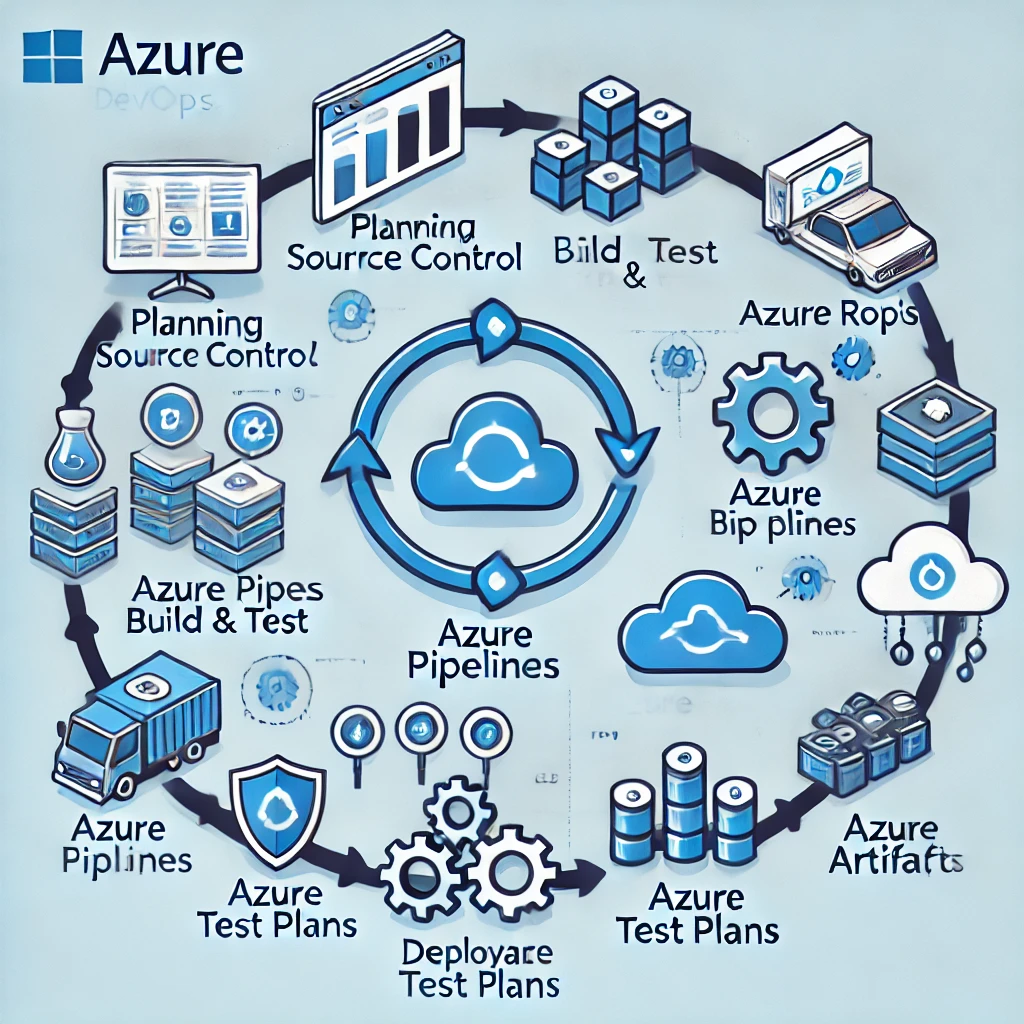Introduction
In today’s fast-paced software development world, teams require robust tools and methodologies to streamline workflows, enhance collaboration, and ensure efficient delivery. Azure DevOps, a suite of development services provided by Microsoft, is one such platform that facilitates continuous integration and continuous deployment (CI/CD), agile project management, and infrastructure as code. This blog explores Azure DevOps, its key components, how it works, and the benefits it offers.

What is Azure DevOps?
Azure DevOps is a cloud-based service that helps development teams plan, develop, test, and deploy applications efficiently. It encompasses a variety of tools that support the entire software development lifecycle (SDLC), making it an essential platform for DevOps teams.
Azure DevOps provides a set of services, including:
- Azure Repos – A source control system that supports Git and Team Foundation Version Control (TFVC). It enables developers to manage their code efficiently, track changes, and collaborate seamlessly.
- Azure Pipelines – A CI/CD service that automates build, test, and deployment processes. It supports multiple programming languages and platforms, allowing for faster and more reliable software delivery.
- Azure Boards – An agile project management tool with Kanban boards, sprint planning, and reporting features. Teams can track work progress, manage backlogs, and improve transparency.
- Azure Test Plans – A comprehensive testing solution for manual and automated testing. It ensures that applications are thoroughly tested before deployment.
- Azure Artifacts – A package management system for storing and sharing dependencies. It allows teams to manage software components effectively and securely.
How Azure DevOps Works
Azure DevOps follows a structured workflow to facilitate continuous development and delivery. Below is an overview of how teams typically use Azure DevOps in their software projects:
Step 1: Planning with Azure Boards
Before development begins, teams use Azure Boards to plan their work. Agile methodologies such as Scrum and Kanban are supported, allowing teams to create and manage user stories, tasks, and bug reports effectively.
Step 2: Source Control with Azure Repos
Developers write code and commit their changes to Azure Repos, which supports both Git and TFVC. Azure Repos ensures version control, allowing multiple developers to work on the same project while keeping track of code changes and history.
Step 3: Automating Builds and Tests with Azure Pipelines
Once code is committed, Azure Pipelines automatically triggers build and test processes. Continuous Integration (CI) ensures that each code commit is tested for errors, while Continuous Deployment (CD) automates application releases to staging and production environments.
Step 4: Testing with Azure Test Plans
Quality assurance teams use Azure Test Plans to perform manual and automated testing, ensuring that the software meets functional and performance requirements. This step helps catch bugs early in the development cycle.
Step 5: Deploying Applications with Azure Pipelines
After passing tests, the application is deployed to different environments using Azure Pipelines. Teams can define deployment strategies such as blue-green deployments and canary releases to minimize downtime and reduce risk.
Step 6: Monitoring and Improving
Post-deployment, teams monitor application performance using tools like Azure Monitor and Application Insights. Feedback is gathered from end users, and improvements are planned for future releases using Azure Boards.
Key Benefits of Azure DevOps
1. Enhanced Collaboration
Azure DevOps fosters team collaboration by providing a single platform where developers, testers, and operations teams can work together seamlessly. With Azure Boards, teams can track progress, assign tasks, and improve transparency.
2. Continuous Integration & Continuous Deployment (CI/CD)
Azure Pipelines automate the build and release process, ensuring that code changes are tested and deployed efficiently. This leads to faster releases with minimal manual intervention and a reduction in human errors.
3. Flexibility & Integration
Azure DevOps integrates seamlessly with third-party tools like Jenkins, Kubernetes, and GitHub. It also supports various programming languages, including Python, Java, .NET, and Node.js, making it highly versatile and adaptable to different development needs.
4. Scalable & Secure
With cloud-based infrastructure, Azure DevOps can scale with your organization’s needs. It offers enterprise-grade security, ensuring compliance with industry standards and regulations such as GDPR and ISO/IEC 27001.
5. Improved Code Quality
Azure Repos and Azure Test Plans enable teams to enforce best practices, conduct thorough testing, and maintain high-quality code. Automated testing ensures that bugs are identified early in the development cycle, reducing technical debt and improving software reliability.
6. Cost Efficiency
By automating workflows, reducing manual interventions, and optimizing resource utilization, Azure DevOps helps organizations cut down on development and operational costs. The pay-as-you-go model ensures that teams only pay for the resources they use.
7. Faster Time to Market
By streamlining development and deployment processes, Azure DevOps helps organizations deliver high-quality software faster. Automated workflows and continuous integration ensure that new features and bug fixes are released more frequently.
Getting Started with Azure DevOps
- Sign Up – Create an Azure DevOps account at Azure DevOps Portal.
- Create a Project – Start a new project and configure repositories, pipelines, and boards.
- Set Up CI/CD – Use Azure Pipelines to automate builds and deployments.
- Manage Workflows – Organize tasks using Azure Boards for effective project management.
- Monitor & Optimize – Use reporting and analytics tools to track progress and improve processes.
Conclusion
Azure DevOps is a powerful platform that enhances software development efficiency by integrating project management, version control, CI/CD, and testing. By adopting Azure DevOps, teams can streamline their workflows, enhance collaboration, and accelerate software delivery. Whether you’re a startup or an enterprise, leveraging Azure DevOps can significantly improve your development lifecycle.
By incorporating Azure DevOps best practices, organizations can achieve faster delivery, higher quality software, and improved team productivity. If you’re looking to modernize your development process, Azure DevOps is a great place to start.
Start your DevOps journey with Azure today and optimize your development process!

Leave a Reply